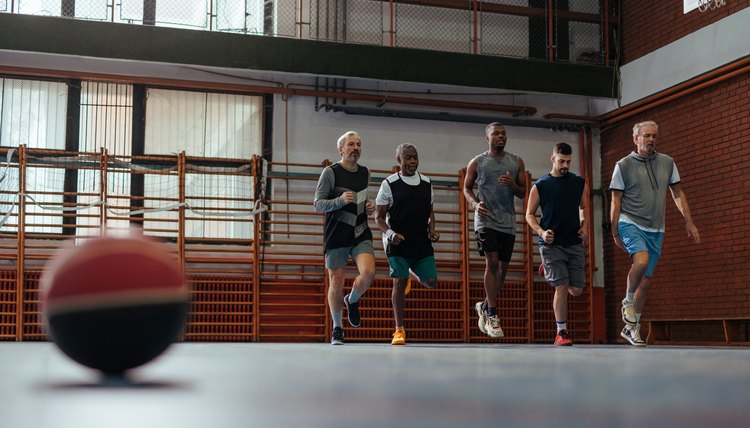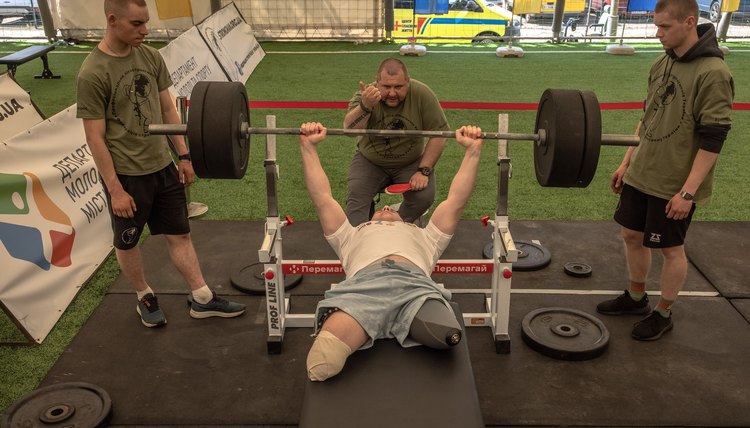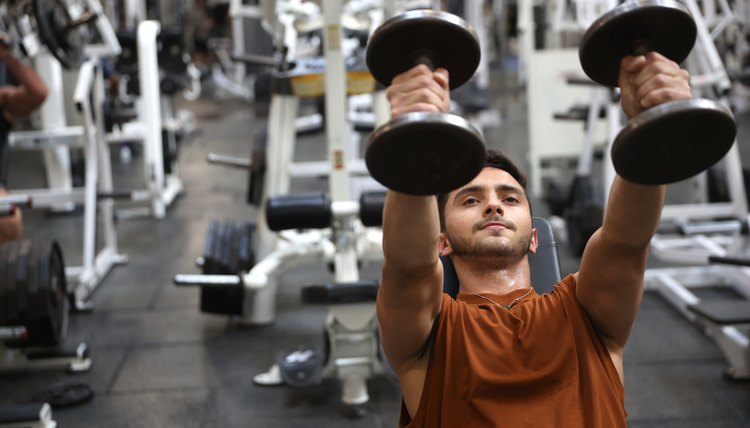Muscles Used During Basketball

Basketball is a dynamic sport that simultaneously activates muscles throughout your body to coordinate complex, multi-joint movements with precision. Playing basketball can help you build muscular endurance, stamina and strength, because it involves constant muscle contractions throughout your entire body and explosive bursts of speed and power.
According to fitness coach and Illinois Basketball Hall of Fame member Danny McClarty, modern basketball players are larger and have more muscle mass than ever before. If you want to stay competitive, strength training workouts can improve your performance by strengthening the major muscles that power basketball moves like sprinting, jumping and shooting.
Butt and Thighs
In your lower body, the primary muscles used when playing basketball are in your butt and thighs. The quadriceps muscles, or quads, which form the front of your thighs, straighten the knee joint every time you run across the court or jump vertically, and they also contract each time your leg goes from a bent to a straight position.
Your hamstrings are the group of muscles that form the back of your thighs, and bend your knee each time you lift your leg to run across the court or squat down in a defensive position or as you prepare to take a shot. The hamstrings also work with the gluteus maximus, or glutes, to hyperextend your hips, which moves your thigh back during running or jumping activities in basketball, such as shooting a basketball, whether that be a jump shot, layup or dunk.

Calves
The calf muscles of your lower leg — the soleus and gastrocnemius, a group referred to as the triceps surae — are responsible for ankle movements that point your toes down and away from your leg.
Your calf muscles contract constantly with each extension of the foot, such as when your heel comes off the ground as you walk or run, or when you push off the ground to jump.
Strengthening the calf muscles also improves your vertical jump for shooting. Just before your feet leave the ground, your calves contract to bring you up on your toes and launch your body into the air.
Developing your leg muscles through exercises such as squats, lunges, jumps, calf raises and sprints can greatly increase your speed, agility and your ability to jump. Each of these attributes are vitally important to becoming a successful basketball player. Strong leg muscles often translate into explosiveness and will allow you to stop and change directions quickly. This quickness can set you apart from slower opponents by allowing you to play more effective defense and get to the basket more easily on offense.

Upper Body
Playing basketball activates muscles throughout your upper body, particularly muscles that control your shoulder joint, shoulder blades, elbows and wrist. Dribbling involves your deltoids, triceps, biceps and forearm muscles. Strong deltoids, pectoral and triceps muscles enable you to shoot the ball over an opponent with more force and power.
The triceps are the most important muscles in the upper body for shooting and passing, followed by the shoulder and chest muscles. The triceps run from your shoulder to your elbow at the back of your upper arm. Contraction of the triceps muscles causes the extension of the arm involved in pushing the ball away from the body, such as when pushing the ball toward the ground to dribble.
Aligning your body for shooting also calls on the deltoids and back muscles. Strong biceps improve your ability to grab rebounds quickly and regain position of the ball.

Core
Your core muscles include the muscles around your hips, lower back and abdomen. The core muscles stabilize all of your body movements while playing basketball by keeping your spine and hip joints in alignment.
The abdominals and erector spinae work together to control the trunk of your body. Hip muscles move your thighs forward as you move around the court, and rotate your lower back when you change direction. Strengthening your core makes all your movements more efficient while playing basketball by adding stability to your joints, which allows different muscle groups to work together more effectively.
These muscles are contracting all the time while you’re playing basketball. Even when you are just standing on the court, these muscles hold your body upright with good posture.

Forearm Muscles
You might be surprised to learn that important muscles responsible for flexing your fingers actually reside in your forearm. The flexor digitorum profondus runs from the elbow to the wrist where it connects to muscles in the fingers. This muscle helps generate the force required to push your fingers forward when shooting the ball. It works in conjunction with the triceps muscles which extend your arm.
Staying Fit and Functional
Basketball is a very physically demanding sport. Preventing injuries may be the most important reason to build muscle. Muscle strength is important in basketball because while gaining strength, speed and endurance, you are also strengthening tendons and ligaments which will reduce the chances of injuries, such as sprains and tears. According to Alan Stein, strength and conditioning coach at Dematha Catholic High School in Maryland, a productive in-season program can take as little as 20 minutes twice a week.
References
Writer Bio
Miguel Cavazos is a photographer and fitness trainer in Los Angeles who began writing in 2006. He has contributed health, fitness and nutrition articles to various online publications, previously editing stand-up comedy and writing script coverage as a celebrity assistant. Cavazos holds a Bachelor of Arts in philosophy and political science from Texas Christian University.
